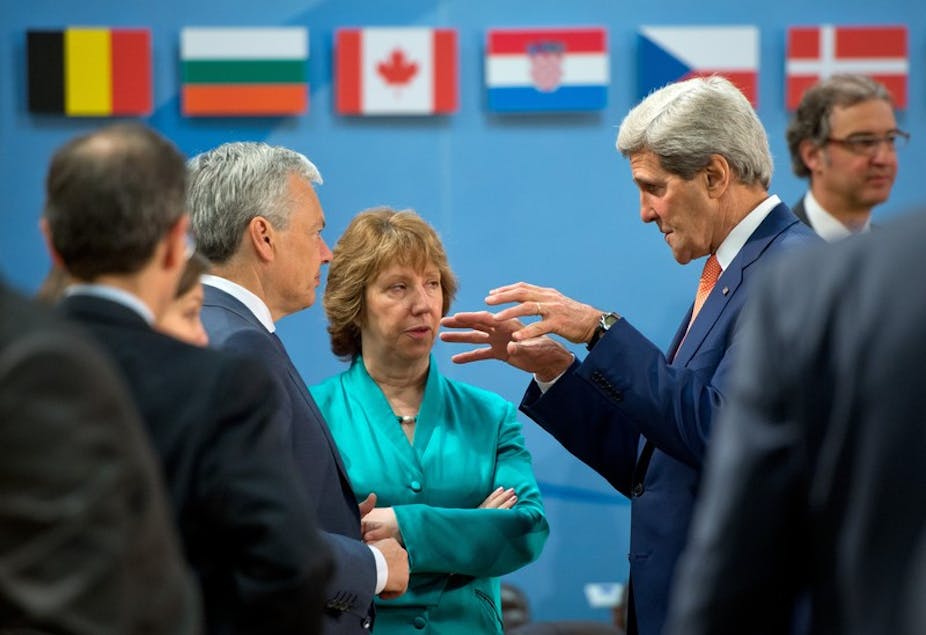On July 31, while it remained unclear exactly how directly involved in the Ukrainian crisis Russia is, the British media ominously reported that Nato had been deemed unready to fight a war with Russia.
The story comes from the Commons Defence Select Committee, in a report Towards the next Defence and Security Review: Part Two – NATO, an analysis of publicly available intelligence on what we know about Russian military forces and how they are using “next generation warfare”.
Mixing it up
Next generation warfare here refers to the use of asymmetric tactics: the deployment of highly trained special forces (Spetznaz), or of psychological operations (PSYOPS), which Russia has long used to goad an adversary into over-committing – as did the Georgians in South Ossetia in 2008.
Russia’s embrace of these methods reflects the lessons it learned in the Soviet-Afghanistan war, just as the US and allied forces have embraced new, unorthodox tactics to get through their recent engagements in Iraq and Afghanistan.
The Baltic states of Estonia, Latvia and Lithuania are the most obvious targets of Russian aggression, and though the overall level of risk is currently low, it is palpably higher than it was before the conflict in Ukraine.
But even as the atmosphere around Russia is as tense as it’s been for decades, the Defence Committee concluded that Nato has little to offer in response to this style of warfare should Russia use it against other members of the alliance.
All in it together
The Committee’s report raises various questions. Most obviously, we might ask why (if the report is to be trusted) Nato is unprepared to deal with next generation warfare. After all, these sorts of tactics were used in Russia’s war in Chechnya, against Georgia, and even against Estonia (a Nato member) in the form of massive Russian cyber attacks in 2007.
The answer is not hard to fathom: much of Nato has not seen Russia as much a military threat until recently, a complacency that dates back to the end of the Cold War. And yet, under Vladimir Putin, the Russian government has invested heavily in refitting and restrengthening its military since the year 2000. At the same time, Russia’s defence development has been outpaced around the world, in particular by the United States but also by the likes of China.
The report also judges Nato itself to be unfit, as opposed to particular alliance members or in particular the US – by far the largest and most powerful member. To be fair, the report is largely an assessment of the UK’s military readiness, rather than the readiness of Nato per se. Yet the fact that Nato still dominates the report’s top line is telling, in that regional security and the capability of member states really cannot be meaningfully discussed outside of the military alliance.
Indeed, if we look across the Nato family, it’s clear that almost every member – while making overtures to the EU where they overlap – sees Nato as the central determinant of its national and regional security. European states in particular, especially in eastern Europe, have little hope (if any) of keeping up with Russia’s defence development. They are therefore especially beholden to the alliance’s success.
Where there’s a will
Nonetheless, the whole point of Nato is that states should not have to match Russia tank-for-tank; the idea of an alliance is that its members should be able to fight back collectively.
Nato’s model of collective protection has always revolved around the US’s tactical nuclear missile defence. Furthermore, through Nato’s history with Russia and before the Soviet Union, there was a need to balance against adversarial forces and deter them from attacking an alliance member. Assured by the commitment to Article V of the North Atlantic Treaty, each member could rest assured that its defence was the responsibility of the whole alliance.
The best challenge to the idea Nato is “unready” is to look at how many Nato militaries are fit for fighting against asymmetric forces. Many in the United States argue that the US Army and Marine Corp have gone too far in this direction, and should be focusing once again on preparing for conventional military conflict against major military powers – China, North Korea and, yes, even a resurgent Russia.
But what the Commons Defence Committee report highlights is many Nato members’ political reluctance to challenge Russia in Ukraine, and to use the threat of force in response to its behaviour first in Crimea, and then in the Donbas. Overall, Nato remains militarily ready, but politically faltering.
When we talk about Nato, we should always treat its military and political aspects as interrelated but separate. Let the symmetrical/asymmetrical warfare debate rage – without showing the political will to defend its members, Nato will indeed be useless should Russia continue to raise hell.
Next, read: Ukraine gives NATO a reason to exist – but big players demur

